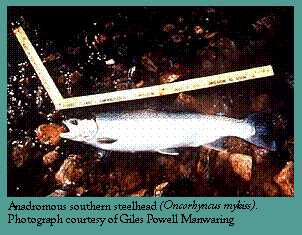Anadromous Fishes
I. Overview of Anadromous Fishes of the Monterey Bay National Marine Sanctuary
U.S.D.A. Forest Service and Hopkins Marine Station
Cabrillo Point, Pacific Grove, CA 93950
I. Overview of Anadromous Fishes of the Monterey Bay National Marine Sanctuary
 More than 80 streams and rivers along the central California coast drain into the Monterey Bay National Marine Sanctuary (MBNMS; Figure 1). Central California's aquatic ecosystems support numerous fish species with diadromous life history patterns that use river and estuarine habitats draining into the MBNMS. Unique behaviors in fishes utilizing both freshwater and marine environments include anadromous fishes (incubation and juvenile rearing in freshwater, maturation at sea, and adult migration into rivers for reproduction), and the primarily marine catadromous fishes which undergo some movement and obligatory life history requirements in freshwater (McDowell 1987).
More than 80 streams and rivers along the central California coast drain into the Monterey Bay National Marine Sanctuary (MBNMS; Figure 1). Central California's aquatic ecosystems support numerous fish species with diadromous life history patterns that use river and estuarine habitats draining into the MBNMS. Unique behaviors in fishes utilizing both freshwater and marine environments include anadromous fishes (incubation and juvenile rearing in freshwater, maturation at sea, and adult migration into rivers for reproduction), and the primarily marine catadromous fishes which undergo some movement and obligatory life history requirements in freshwater (McDowell 1987).Today, many native anadromous fish stocks throughout California are in danger of extinction as a consequence of poor resource stewardship and the general degradation of the freshwater and estuarine aquatic ecosystems (Nehlsen et al. 1991). California's coho salmon stocks represent only 6% of their historic 1940's estimates (Brown et al. 1994), and anadromous steelhead runs south of San Francisco Bay represent less than 2% of their historic abundance (Titus et al. in press). Nongame fish species have suffered no worse a fate with many coastal diadromous populations virtually extinct (Swift et al. 1993).
The importance of anadromous fishes as part of the MBNMS ecosystem is poorly documented, with most scientific research and monitoring being focused on the freshwater life stages of the salmonids. The evolutionary significance of the anadromous fish stocks found in central California coastal waters, however, cannot be denied. Recent genetic analyses have demonstrated unprecedented divergence in the southern extent of the range in salmonids dating back to the Pleistocene glacial times (Nielsen et al. 1994a, b). The following narrative summarizes the anadromous salmonids found in waters associated with the MBNMS.
| < Previous Anadromous Fishes TOC |
||
